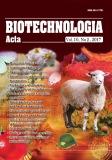"Biotechnologia Acta" V. 10, No 2, 2017
https://doi.org/10.15407/biotech10.02.034
Р. 34-39, Bibliography 9, English
Universal Decimal Classification: 579.841.11:577.114.083:578.865.1

ANTIVIRAL ACTIVITY OF LIPOPOLYSACCHARIDES OF Pseudomonas chlororaphis subsp. aureofaciens
L .D. Varbanets1, S. L. Rybalko2, D. B. Starosyla2
1Zabolotny Institute of Microbiology and Virology of the National Academy of Sciences of Ukraine, Kyiv
2Gromashevskyi Institute of Epidemiology and Infectious Diseases of the National Academy of Medical Sciences, Kyiv
The aim of the study was to investigate the ability of lipopolysaccharides of two strains of Pseudomonas chlororaphis subsp. aureofaciens to inhibit in vitro the reproduction of human viruses: influenza A/FM/1/47 (H1N1), herpes simplex type 2 and bovine diarrhea, which is used as a model of hepatitis C virus, as well as to suppress hepatitis C virus production in model system of cells transfected with cDNA of this virus. It has been established that for both lipopolysaccharides in three types of cultures (MDCK, Vero and MDBK) the toxicity is not manifested even in a concentration of 100.0 μg/ml, and decreasing in infectious virus titer more than by 2.0 lg TCD50 (ED99) was already achieved at concentrations of 1.55 mg/ml. Selectivity indexes determination of lipopolysaccharides preparations against the influenza A/FM/1/47 (H1N1) virus, herpes simplex virus type 2 and bovine diarrhea virus shows that lipopolysaccharides of P. chlororaphis subsp. aureofaciens UCM B-306 and UCM B-111 are effective inhibitors of investigated viruses reproduction: selectivity index is at least 64. In the model of Jurkat cells transfected with human hepatitis C virus cDNA, viral RNA loading was determined in cells treated with lipopolysaccharides of P. chlororaphis subsp. aureofaciens. The results of the studies indicate that when lipopolysaccharides of both strains are administered, the production of the hepatitis C virus is completely inhibited.
Keywords: Pseudomonas chlororaphis subsp. aureofaciens lipopolysaccharides, influenza, herpes and hepatitis C viruses.
© Palladin Institute of Biochemistry of National Academy of Sciences of Ukraine, 2017
References
1. Babushkina A.V. Upper respiratory diseases and bronchoobstructive syndrome. Ukr. Medyichnyi chasopys. 2011, (81) (1), 1-11. (In Russian).
2. D'yachkova S.YA., Nikolayevskiy V.A. Antiviral means. Voronezh, 2008, 149 p. (In Russian).
3. Solov’ev V.D., Bektemirov T.A. Interferon. Theory and Applications. N. Y.: Plenum Press. 1973, 304 p.
4. Helfgott D.C. Bacterial lipopolysaccharides (exotoxin) enhances expression and secretion of B2 interferon by human fibroblastes. J. Exp. Med. 1987, 166 (5), 1300-1309. https://doi.org/10.1084/jem.166.5.1300
5. Kiprianova E.A., Varbanets L.D., Shepelevich V.V., Voichuk S.I. Antiviral activity of lipopolysaccharides of Pseudomonas chlororaphis subsp. aureofaciens. Biotechnol. acta. 2013, 6 (2), 68–73. (In Russian).
6. Kiprianova E.A., Varbanets L.D., Rybalko S.S., Shepelevich V.V. The strain Pseudomonas chlororaphis subsp. aureofaciens – producer of lipopolysaccharide with antiviral activity. Patent Ukrainy № 76689 С12N 1/100 MPK 10.01.2013. (In Ukranian).
7. Buckwold V.E., Beer B.E., Donis R.O. Bovine viraldiarrhea virus as a surrogate model of hepatitis C virus for the evaluation of antiviral agents. Antivir. Res. 2003, V.60, P. 1-15. doi.org/10.1016/SO166-3542(03)00174-8.
8. Varbanets L.D., Zdorovenko E.L., Kiprianova E.A., Avdeeva L.V., Brovarskaya O.S., Rybalko S.L. Characterization of the lipopolysaccharide of Pseudomonas chlororaphis. Microbiology (Moscow). 2015, 84 (6), 781–790. https://doi.org/10.1134/S0026261715060132
9. Zdorovenko E, Kadykova A., Varbanets L., Shashkov A.S., Kiprianova E., Brovarskaya O., Knirel Yu. Structure of the O-specific polysaccharides of Pseudomonas chlororaphis subsp. chlororaphis UCM B-106. Carboh. Res. 2016, V. 433, P. 1–4. https://doi.org/10.1016/j.carres.2016.06.013

